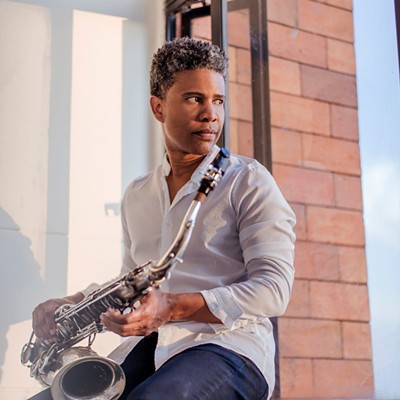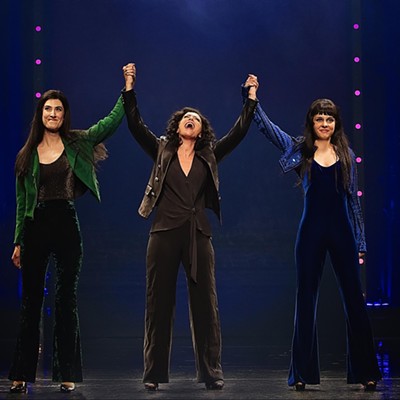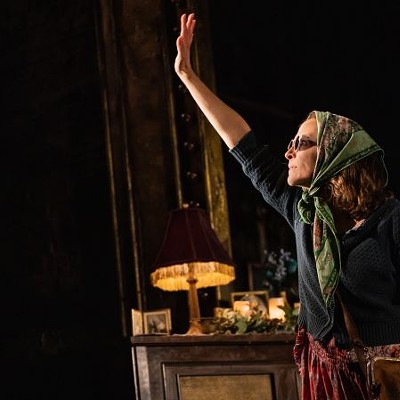The set-up:
Having just seen Theatre Southwest's production of Christopher Durang's wacky Vanya and Sonia and Masha and Spike, some dialogue slapped me upside the head that might best describe what's gone wrong over at Bayou City Theatrics in its production of F. Scott Fitzgerald's 1925 jazz-age novel.
Innocent, hopeful Nina asks the aged movie star Masha what's the difference between acting in a movie and acting on stage. Masha proclaims in her best diva immitation, “In film, you are acting in front of a camera, and you need to speak in a normal voice. And onstage, you are in a sort of wooden box in front of people who are looking at you and you must speak more loudly. So that they can hear you.”
Everyone's awfully quiet at Kaleidoscope. Unfortunately, the Victor Talking Machine upstage on the twin-level set is awfully loud. When the revelers in West Egg, Long Island, start dancing to Gershwin and Caesar's 1919 romance,“I Was So Young, You Were So Beautiful,” you can't hear the actors. When the gramophone turns off, you can't them either. What's going on?
The execution:
There are some good old-fashioned leather lungs up there. I know, I've heard them clearly in other venues: Sam Martinez, Nathasha Gorel, Jason Duga, Brennan Ashley. They've always projected over the footlights. What happens in this shoebox space to muffle everyone? Why does everybody speak like they don't want us to hear them? Must actors today be miked even in the elongated space of BCT? Maybe.
But I don't think that's the true problem. There's a woeful lack of stage presence in Gatsby. The absence of vocal oomph is the least of BCT's problems. With the exception of those actors named above, no one looks comfortable being on stage. Is this a classic case of miscasting, too little rehearsal time, or amateurs in place of pros? I don't know, but never have I seen so much fidgeting, hands flying into and out of pockets, hair straightening, and shuffling from one foot to another from any ensemble. They're all at sea, and it makes me, for one, fairly uncomfortable. I start to twitch and tic, too; my foot swings back and forth, I get distracted.
I'm supposed to be watching this classic of American lit (pretty much a bomb upon publication, GG came into its own once its original decade of the Roaring '20s was long past), and all I can think of is, Is this actor going to make it off stage without bumping into the turntable or getting lost in the diaphanous white curtains flanking the stage? Is that cloche hat going to stay put? Is the gun going to go off? I'm no longer lost in the world of flappers, bootleg booze, and “careless people,” but watch from a distance. I'm an outsider, like Fitzgerald's not-so-innocent Nick Carraway. The tale's never given a chance to work its magic because the audience is so thrown off by the clunky stuff it has to endure on stage.
Scenes start or end without punctuation, visual or dramatic. The sound's way over modulated and loud. The actors are out of their league. The costumes, when they fit, look right; the wigs do not. The split-level set is never used in any concrete way. But then, director Colton Berry throws us for a loop, and suddenly the staging comes alive in marvelous ways we'd never expect. Like Myrtle's death – hit by Gatsby's car – depicted as blinding headlights behind those billowy curtains. Or the simple way a scene change is effected: a table placed over another one, voila, a bedroom. It's these kind of imaginative theatrical effects that make us pine for what isn't accomplished.
The verdict:
Other than the early Gershwin song which is so contextually right for Gatsby, the opening seconds have more atmosphere in them then the entire play. (Adapted by Simon Levy, this is the only stage version sanctioned by the Fitzgerald estate.) Surrounded by those white curtains, a tiered platform sits center stage. The floor is sectioned off in a grid of squares, some type of Art Deco look with metallic grout. On the platform is what seems to be a white table and perhaps another table placed on top facing the other way. The arrangement looks like a catafalque, a dream tomb perhaps. An absinthe wash veils the stage, and a light mist falls. It looks like the pallor of death. It took me a few minutes to realize...oh, the green, get it...that's the light at the end of Daisy's dock, calling to Gatsby, reminding him of their lost love, taunting him of her presence, forever out of reach, so near yet so far. Whatever it's supposed to mean, this foreboding stage picture spins its own enchantment, setting the bar high for what's to come. What comes after is one big letdown.
The Great Gatsby continues through September 27 at The Kaleidoscope, 705 Main Street (entrance on Capitol). Purchase tickets online at bayoucitytheatrics,com or call 832-817-8656. $35-$45.
Support Us
Houston's independent source of
local news and culture
account
- Welcome,
Insider - Login
- My Account
- My Newsletters
- Contribute
- Contact Us
- Sign out
The Great Gatsby Trips Up Over Technical Problems, Acting Twitches
D. L. Groover September 15, 2015 10:00AM
[
{
"name": "Related Stories / Support Us Combo",
"component": "11591218",
"insertPoint": "4",
"requiredCountToDisplay": "4"
},{
"name": "Air - Billboard - Inline Content",
"component": "11591214",
"insertPoint": "2/3",
"requiredCountToDisplay": "7"
},{
"name": "R1 - Beta - Mobile Only",
"component": "12287027",
"insertPoint": "8",
"requiredCountToDisplay": "8"
},{
"name": "Air - MediumRectangle - Inline Content - Mobile Display Size 2",
"component": "11591215",
"insertPoint": "12",
"requiredCountToDisplay": "12"
},{
"name": "Air - MediumRectangle - Inline Content - Mobile Display Size 2",
"component": "11591215",
"insertPoint": "4th",
"startingPoint": "16",
"requiredCountToDisplay": "12"
}
,{
"name": "RevContent - In Article",
"component": "12527128",
"insertPoint": "3/5",
"requiredCountToDisplay": "5"
}
]
KEEP THE HOUSTON PRESS FREE...
Since we started the Houston Press, it has been defined as the free, independent voice of Houston, and we'd like to keep it that way. With local media under siege, it's more important than ever for us to rally support behind funding our local journalism. You can help by participating in our "I Support" program, allowing us to keep offering readers access to our incisive coverage of local news, food and culture with no paywalls.
D.L. Groover has contributed to countless reputable publications including the Houston Press since 2003. His theater criticism has earned him a national award from the Association of Alternative Newsmedia (AAN) as well as three statewide Lone Star Press Awards for the same. He's co-author of the irreverent appreciation, Skeletons from the Opera Closet (St. Martin's Press), now in its fourth printing.
Contact:
D. L. Groover
Trending Arts & Culture
- Houston Bookstore Crawl Celebrates Small Businesses and Literary Diversity
- Reviews For The Easily Distracted:
Abigail - The Story Stalls But The Beat Goes On in The Cher Show at TUTS
-
Sponsored Content From: [%sponsoredBy%]
[%title%]

Don't Miss Out
SIGN UP for the latest
arts & culture
news, free stuff and more!
Become a member to support the independent voice of Houston
and help keep the future of the Houston Press FREE
Use of this website constitutes acceptance of our
terms of use,
our cookies policy, and our
privacy policy
The Houston Press may earn a portion of sales from products & services purchased through links on our site from our
affiliate partners.
©2024
Houston Press, LP. All rights reserved.





